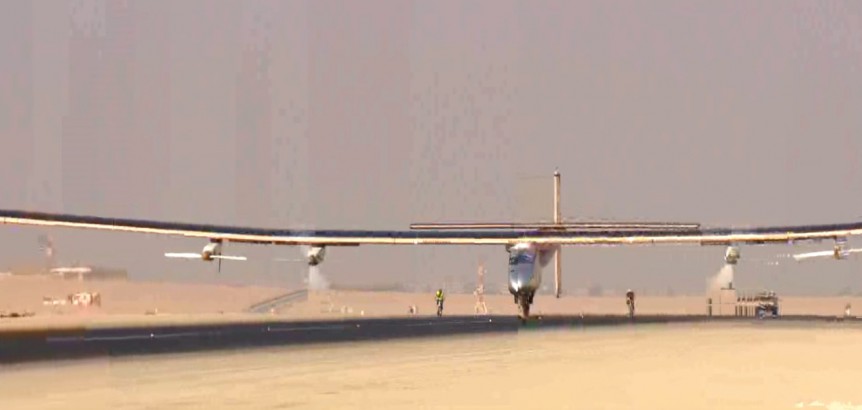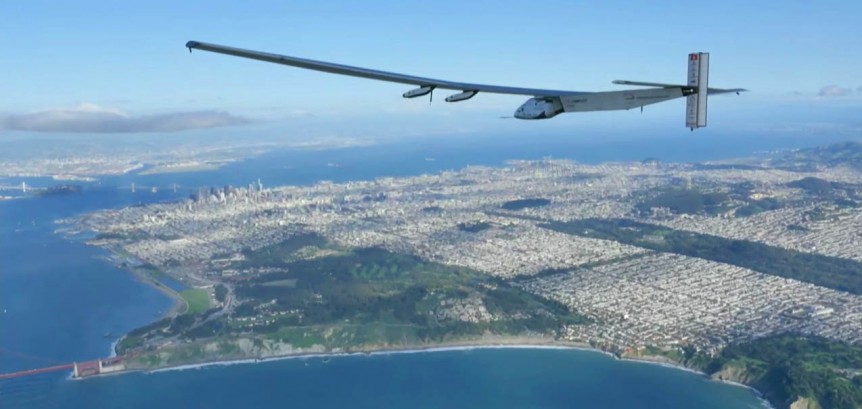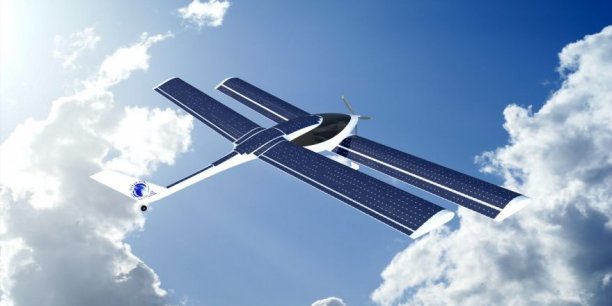Headlines all over the world are sharing the word of the day – penultimate, meaning the next to the last* – in this case the next to last flight for Solar Impulse 2. The Guardian newspaper explained, “After setting off from Seville on Monday morning, the plane passed through Algerian, Tunisian, Italian and Greek airspace, and flew over the Giza Pyramids before touching down at Cairo airport at around 7.10am (5.10am GMT). Its support crew cheered as the plane, no heavier than a car but with the wingspan of a Boeing 747, landed, and trailed after it on bicycles.” Which brings up a question – why are the guys on foot outrunning the guys on the expensive electric bicycles? Certainly, the flight led to some spectacular photo opportunities. Passing over the Gemasolar plant shortly after takeoff from Seville, Andre’ Borschberg looked down on “The first commercial-scale plant in the world to apply central tower receiver and molten salt heat storage …
Solar Impulse 2 Gets a Jet Escort
Following a fairly non-eventful crossing of the Atlantic, Bertrand Piccard was greeted by a welcoming formation of Casa C-101 Aviojets, Spain’s Patrulla Águila flight demonstration team. After three days and nights in the air, Piccard landed in the Spanish sunrise, also finalizing efforts to establish the International Committee of Clean Technology (ICCT), whose goal is to continue Solar Impulse’s legacy, “promoting concrete energy efficient solutions in order to solve many of the challenges facing society today.” While “Until recently, protecting the environment was expensive and threatened our society’s comfort, mobility and growth. Today, thanks to modern clean technologies, the energy consumption of the world, and therefore the C02 emissions, could be divided by two, while creating jobs and enhancing profits. The International Committee of Clean Technologies will work in this direction,” Bertrand Piccard and Andre’ Borschberg launched the #futureisclean initiative a few months ago. A non-governmental organization composed of 400 global organizations. It has been endorsed by patrons such as H.S.H. …
Solar Impulse’s Great Photo Op – and Special Birthday Guest
Saturday night, if you were lucky enough to be wandering the streets of New York City, you would have seen a string of lights slowly crossing the sky above the Statue of Liberty, a stirring sight – especially for those following the over-year-long flight of Solar Impulse 2. Andre’ Borschberg had flown the giant electric airplane from the Lehigh Valley of Pennsylvania to the night skies over Manhattan, landing finally at John F. Kennedy International Airport. The airplane will pause briefly before departing on a trans-Atlantic flight to an as-yet undisclosed location in Europe, from which it will make the final leg of the journey, returning to Abu Dhabi in the United Arab Emirates. “The Statue of Liberty is a symbol of American values: the liberty to be a pioneer, the freedom to explore and invent. It welcomes travelers who arrive in this country, and flying over it was a tribute we paid for the special welcome we received at …
Vin Fiz and Solar Impulse
Calbraith Perry Rodgers, the first person to fly across the United States, was deaf from an early childhood disease. Even though he came from a long line of naval heroes, this handicap kept him from joining the Navy, but didn’t slow his quest for adventure. He was one of the first to sign up for flying lessons with the Wright Brothers at their home base in Ohio. He was 31 years old when William Randolph Hearst offered a $50,000 prize to the first aviator to fly coast-to-coast in 30 days or less. Rodgers convinced the Armour Meat Packing Company to sponsor his attempt as a promotion for their new soft drink, Vin Fiz. As a coincidence, your editor visited the Hiller Aviation Museum a few weeks ago, and they have a beautiful replica of the Wright Model EX in Vin Fiz markings, just as it looked when Rodgers set out from Sheepshead Bay, Long Island, New York, on September 17, …
Solar Impulse Makes it to Mountain View
At 11:44 PDT, April 22, Solar Impulse 2, expertly piloted by Bertrand Piccard through tricky winds above Moffett Airfield, made its second landing in the United State, almost three years after Solar Impulse 1 had left on its flight eastward* and just in time to close out Earth Day. HB-SIA (Solar Impulse 1) made its trip across America in six hops, none lasting more than 21 hours and 22 minutes. HB-SIB (Solar Impulse 2) flew six hops between Abu Dhabi and Nanjing, China emulating the stages of the American crossing in distance and duration. Things reached record-setting levels after that. The 44-hour trip from Nanjing to Nagoya, Japan gave pilot Andre’ Borschberg a real workout, followed by his record-setting 117-hour epic voyage from Nagoya to Kalaeloa, Hawaii. Fellow pilot Bertrand Piccard finished the trans-pacific flights with a 62-hour flight to San Francisco. The pilots could not do this without a large ground crew, seemingly perpetually busy with preparations, maintenance, and …
A Solar-Algae Hybrid for an Atlantic Crossing
Henri Mignet was never quite able to master an airplane with three-axis controls, and built at least seven flawed attempts at simplified controlled flight. His seminal try, the HM-8 Pou de Ciel (literally, Louse of the Sky, or more familiarly, Flying Flea) became first a matter of celebration for amateur aviators and then a cause of scandal, being banned in Britain following a series of fatal crashes. The “formula”, as proponents called Mignet’s tandem wing configuration, was sorted out after wind tunnel tests in England and America uncovered the flaw that caused the craft to pitch down in an unrecoverable dive. (For a well-illustrated history of Mignet’s design, see Henri Mignet and his Flying Fleas by Ken Ellis and Geoff Jones. Although out of print, used copies are available at Alibris and Abe Books, at higher prices than your editor paid for his new copy 25 years ago.) Later models of the formula have proven to be safe, stable fliers, …
Green Aviation at COP21
COP21, the Congress of Parties 21 – the 21st gathering of nations and organizations working toward an agreement on reducing greenhouse gases, has concluded with what many conclude to be a historic turn from fossil fuels to cleaner, greener means of powering the world’s economy. At a gala “SolutionsCOP21 – Celebrate the Champions Night” at the Grand Palais on the Champs-Élysées in Paris, leaders in demonstrating clean energy solutions were honored and awarded. Globe-straddling solar aviation and electric commuter helicopters showed a few of the environmentally conscientious directions aviation has taken and in which sustainable flight can take flight in the near future. Eraole, Mignet’s Formula Redefined Eraole, with its first motor run at COP21, is a tandem-winged cruiser that will fly on a combination of solar power and biologically-derived algae fuel driving its single electric motor. The 14 meter wings and large horizontal tail provide space for 43 square meters (462.8 square feet) of 24-percent efficient solar cells. These …
Solar Impulse Stays in Hawaii until Next Year
A sign on the climb from Salem, Oregon to the Redmond/Bend area indicates that no gas or services exist for the next 52 miles. It’s worth heeding, since the route goes over mountain passes, and in winter can require tire chains and sometimes long passages behind a snow plow. Range anxiety happens even for those of us still plugging along in fossil-fueled vehicles. One of the ostensible advantages of Solar Impulse’s ability to charge itself, is that it has an endless supply of solar fuel and its batteries can make it through the night – depending on the relative lengths of day and night. Making the longest flight of the round-the-world trip at high latitudes and during summer months was well planned, subject only to obstacles presented by weather. Even those impediments were handled brilliantly by the team’s meteorologists and mission director. What couldn’t be foreseen and must have caused moments when Andre’ Borschberg’s discipline, yoga and powers of meditation …
Solar Impulse – Tougher than it Looked
The record-breaking flight from Nagoya, Japan to Kalaeloa, Hawaii by Andre’ Borschberg in Solar Impulse had more difficulties than were immediately apparent to even the most involved observer. During the first climb out of Nagoya, some of the cells mounted behind each motor experienced overheating, now attributed to over-insulation. High-density foam packed around the cells was apparently too effective for even the freezing temperatures at altitude and caused the batteries to become warmer than desired. As explained on the Solar Impulse web site, “The energy collected by the solar cells is stored in lithium polymer batteries, whose energy density is optimized to 260 [Watt-hours per kilogram]. The batteries are insulated by high-density foam and mounted in the four engine nacelles, with a system to control charging thresholds and temperature. Their total mass amounts to 633 [kilograms] (1,393 pounds), or just over a quarter of the aircraft’s all-up weight. “In order to save energy, the aircraft climbs to 8,500 meters (27,887 …
Solar Impulse Breaks More Records, Attracts More Eyes
At 79 hours into the flight Flight Director Michi Anger let viewers on Solar Impulse’s web site know that the “U-turns” the airplane performed were to get the maximum amount of solar energy in the plane – “That’s why it looks as if we’re facing the wrong direction.” “André got a good amount of rest during the last 12 hours, but we had some problems finding calm air. André had 300m of resting periods but could only sleep for 170m. The autopilot is designed to function only in calm air so we had to wake André up from the MCC. This is a rude awakening for him so it made it more difficult for him to go back into sleep. “André passed 76h 45min of flight, breaking Steve Fossett’s 2006 record for the longest solo flight (in any kind of plane). “In a few hours SI2 will climb up to 28 000ft until “Energy-Neutral Evening”, the point at which there will not be enough solar power to charge batteries. “Holding pattern: we’re slowing down the flight to ensure we …




